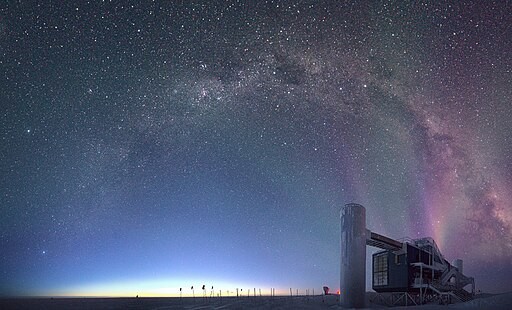Classical physics describes the phenomena in our everyday surroundings, such as gravity, while the atomic world can only be described using quantum mechanics. Uniting quantum theory and gravitation remains one of the most outstanding challenges in modern physics.

(Photo: Wikimedia Commons/ John Hardin)
One mystery lies in the quantum nature of spacetime, a fusion of the three dimensions of space and the fourth dimension of time. It is also debated whether it is subject to the randomness observed in other quantum theories and results in fluctuations at minimal distances and times.
Search for Neutrino Decoherence
Several thousands of sensors are distributed over more than a square kilometer near the South Pole to find the existence of quantum gravity. These sensors monitor neutrinos that arrive at the Earth from outer space. To find out if quantum gravity exists, a group of researchers from the Niels Bohr Institute (NBI), University of Copenhagen, has contributed to the development of a method for exploiting neutrino data.
The study was conducted in IceCube Neutrino Observatory near Amundsen-Scott South Pole Station in Antarctica. Compared to other astronomy and astrophysics facilities, IceCube observes space in the Northern Hemisphere. Although a neutrino can penetrate the Earth, different particles will be stopped. This means the researchers can obtain a much cleaner signal for neutrinos from the Northern Hemisphere.
Traveling Undisturbed Through Earth
The research team was able to study over 300,000 neutrinos, although they are not the type that originate from sources in deep space. Instead, the neutrinos used in this research were created in Earth's atmosphere as high-energy particles from space collided with nitrogen or other molecules.
Neutrino has no electrical charge and is almost massless, undisturbed by electromagnetic and strong nuclear forces. This property enables neutrinos to travel billions of lightyears through the cosmos in its original state.
Therefore, the question is whether the properties of the neutrino are completely unchanged while traveling over large distances or if tiny changes are notable after all. If the neutrino undergoes the subtle changes that the researchers suspect, this would be the first strong evidence of quantum gravity, according to NBI assistant professor Tom Stuttard.
Neutrinos can have three fundamental configurations or flavors: electron, mu, on, and tau. These observable configurations can change in a strange phenomenon called neutrino oscillation. This behavior is called quantum coherence, and it is maintained over thousands of kilometers or more.
Quantum coherence is easily broken in most experiments, although this is not due to quantum gravity. Researchers would want a perfect vacuum in conducting experiments, but a few molecules somehow manage to sneak in. Meanwhile, neutrinos are aruniqueal because they are unaffected by matter around them.
For many years, physicists have doubted whether experiments could test quantum gravity. The recent study's results show that this phenomenon is indeed possible with future measurements involving astrophysical neutrinos. Since more precise detectors are expected to be built in the coming decade, scientists hope that this fundamental question in physics will finally be answered.
RELATED ARTICLE: Astronomers Detect Rare Neutrinos Dubbed Ghost Particles Spewing From Milky Way Galaxy
Check out more news and information on Neutrinos in Science Times.



![Earth's Quasi-Moon Kamo‘oalewa Could Originate From Lunar Surface Not Asteroid Belt [Study]](https://1721181113.rsc.cdn77.org/data/thumbs/full/53275/89/56/50/40/earths-quasi-moon-kamo-oalewa-could-originate-from-lunar-surface-not-asteroid-belt-study.png)










